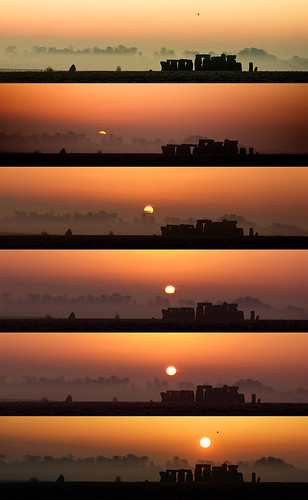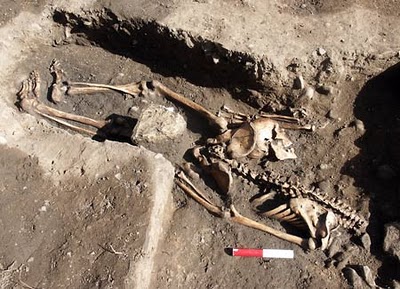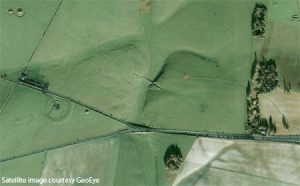Do certainly take along a large amount of recording equipment.
Especially when you’re a large troop – or a very enthusiast couple – visiting Stonehenge, nothing is stopping you from taking along as many different recording devices as the total amount of arms can carry. Where as device Xmight be perfectly fitted for occasion Y, you could prefer device Z for situation N. An example:
- The Sony HDVcamera (carried by Jon) – Excellent tool if you stumble over pagans & druids with interesting stories.
- Canon ‘Rebel’ 300D (weapon of choice for Ann) – Nothing wrong with using ancient tools! When equipped with a wide angle lens, allowing you great reach, this silver veteran will give you a great chance in the battle for most interesting Stonehenge footage. (Just in case you want a more realistic look on things, take a decent 50mm prime along! ;))
- Nikon D70 with 18-200mm lens mounted (commander Meral) – Rumoured to be the “ultimate lens” with magical VRpowers. Great for capturing sunrise from the obliged long distance.
- Sony DCR-HC37E (obeyed to Alasdair) – …
- iPhone (in Scott‘s back pocket) – Well, err…if you’re lucky this might be able to find out your geolocation or even point you in the right direction when lost. But there’s a reason it says ‘iPhone’ and not ‘iCamera’ or ‘iCapture’. 😉
- Nikon D40 (operated by Rebecca) – …
When doing this, don’t forget to settle up front if you’re allowed to touch each other’s stuff! 😉 Things we did not take along – either because we don’t own them, the bus was too small or forgot about it – but that you could consider: a satellite radio dish to record alien communications, sonar equipment to check for bats & underground gnomes and a tripod.
Don’t miss out on the sunset and/or sunrise
 We assume you won’t spend a whole day at Stonehenge, but plan your trip in such a way that you either arrive there at dawn or leave around dusk.
We assume you won’t spend a whole day at Stonehenge, but plan your trip in such a way that you either arrive there at dawn or leave around dusk.
The stones won’t be accessible at that time – except when you book a special tour or attend the solstices – so do take along a food, drinks and a zoom lens – but the view is definitely worth the extra time spend! If you go at dawn like we did, taking these extras along is advised:
- a tripod
- hot drinks
- breakfast
- zoom lens
- gloves
- an extra pair of socks
You can either try to shoot through the fence (a lens with small diameter is needed) or go up the nearby dust road to shoot from a far.This time lapse photograph is taken from that road, using the wooden fence as tripod, with a 50mm prime.

Do take at least one great photograph, regardless of the weather
We were pretty lucky that our field trip to Stonehenge took place on one of those few days that Britain is sunny, but as they say, you can’t control the weather, what you can do, is take a great shot, no matter if the sun is shining full force, or it’s raining cats and dogs.
Sunny Weather
- Don’t shoot directly into the sun (except at sunset or sunrise).Why not? If you shoot directly into the sun, the sky in your photograph will be washed out – all white – or your stones to dark. You will also miss out on the lovely textures that are so typical for the megalithes, showing years of decay and humans with sharp objects.
- Do shoot with the sun on your left or right, or at least not straight behind or straight ahead of you, this is the best way to capture the stone’s textures.(They are lit from aside.)
- Underexpose 1 stop, if your camera allows it. This will ensure you have a pretty blue sky.
- Use global light metering (thus the sky and the stones) instead of point metering (if your camera allows it).
Rainy, Greyish & Stormy Weather
- Take along an umbrella and a person to hold that inexpendable tool.Of course, if you have a rain cover for your camera, that will do too.
- Make sure to expose that way that the “grumpiness” of the sky is visible, most of the time, this means underexposing one stop.
- Focus on the bluestones, which got their name for turning blue when moist.
- Try low ISOvalues, small aperture, long exposure and a tripod, so the rain is clearly visible in your shot. (This works fine with fog too.)
If done well, these ‘dark’ shots often are more appealing to the eye then their sunny counterparts, adding to the mystery that is Stonehenge. Plenty of examples of this can be found on Flickr.
Don’t forget to show off your best photographs
Not everybody is as lucky as to go to Stonehenge, or when we do, we most likely only experience one type of weather.If you have a Flickr account, please do consider sharing your photographs with the world – and especially that part of the world interested in Stonehenge – by tagging them with ‘Stonehenge’ and submitting them to the following Flickr groups:
- Heritage Key – Our very own Flickr pool, gathering the best that is ancient.Who knows, your picture might be chosen to be showcased on the Stonehenge page – of course with attribution! – and you might even make it into Heritage Key Select.
- Stonehenge – Need Isay more?
- Stone Circles – Because although it might be the most famous, Stonehenge is definitely not the only stone circle out there.



